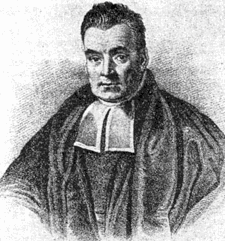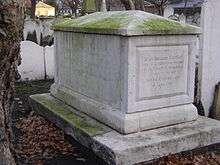Thomas Bayes
| Thomas Bayes | |
|---|---|
 | |
| Born |
c. 1701 London, England |
| Died |
7 April 1761 (aged 59) Tunbridge Wells, Kent, England |
| Residence | Tunbridge Wells, Kent, England |
| Nationality | British |
| Alma mater | University of Edinburgh |
| Known for | Bayes' theorem |
| Scientific career | |
| Fields | Statistics |
| Signature | |
|
| |
Thomas Bayes (/beɪz/; c. 1701 – 7 April 1761)[2][3][note a] was an English statistician, philosopher and Presbyterian minister who is known for formulating a specific case of the theorem that bears his name: Bayes' theorem. Bayes never published what would become his most famous accomplishment; his notes were edited and published after his death by Richard Price.[4]
Biography
Thomas Bayes was the son of London Presbyterian minister Joshua Bayes,[5] and was possibly born in Hertfordshire.[6] He came from a prominent nonconformist family from Sheffield. In 1719, he enrolled at the University of Edinburgh to study logic and theology. On his return around 1722, he assisted his father at the latter's chapel in London before moving to Tunbridge Wells, Kent, around 1734. There he was minister of the Mount Sion chapel, until 1752.[7]
He is known to have published two works in his lifetime, one theological and one mathematical:
- Divine Benevolence, or an Attempt to Prove That the Principal End of the Divine Providence and Government is the Happiness of His Creatures (1731)
- An Introduction to the Doctrine of Fluxions, and a Defence of the Mathematicians Against the Objections of the Author of The Analyst (published anonymously in 1736), in which he defended the logical foundation of Isaac Newton's calculus ("fluxions") against the criticism of George Berkeley, author of The Analyst
It is speculated that Bayes was elected as a Fellow of the Royal Society in 1742[8] on the strength of the Introduction to the Doctrine of Fluxions, as he is not known to have published any other mathematical works during his lifetime.
In his later years he took a deep interest in probability. Professor Stephen Stigler, historian of statistical science, thinks that Bayes became interested in the subject while reviewing a work written in 1755 by Thomas Simpson,[9] but George Alfred Barnard thinks he learned mathematics and probability from a book by Abraham de Moivre.[10] Others speculate he was motivated to rebut David Hume's argument against believing in miracles on the evidence of testimony in An Enquiry Concerning Human Understanding.[11] His work and findings on probability theory were passed in manuscript form to his friend Richard Price after his death.

By 1755 he was ill and by 1761 had died in Tunbridge Wells. He was buried in Bunhill Fields burial ground in Moorgate, London, where many nonconformists lie.
Bayes' theorem
Bayes' solution to a problem of inverse probability was presented in "An Essay towards solving a Problem in the Doctrine of Chances" which was read to the Royal Society in 1763 after Bayes' death. Richard Price shepherded the work through this presentation and its publication in the Philosophical Transactions of the Royal Society of London the following year. This was an argument for using a uniform prior distribution for a binomial parameter and not merely a general postulate.[12] This essay contains a statement of a special case of Bayes' theorem.
In the first decades of the eighteenth century, many problems concerning the probability of certain events, given specified conditions, were solved. For example: given a specified number of white and black balls in an urn, what is the probability of drawing a black ball? Or the converse: given that one or more balls has been drawn, what can be said about the number of white and black balls in the urn? These are sometimes called "inverse probability" problems.
Bayes' "Essay" contains his solution to a similar problem posed by Abraham de Moivre, author of The Doctrine of Chances (1718).
In addition, a paper by Bayes on asymptotic series was published posthumously.
Bayesianism
Bayesian probability is the name given to several related interpretations of probability as an amount of epistemic confidence – the strength of beliefs, hypotheses etc. –, rather than a frequency. This allows the application of probability to all sorts of propositions rather than just ones that come with a reference class. "Bayesian" has been used in this sense since about 1950. Since its rebirth in the 1950s, advancements in computing technology have allowed scientists from many disciplines to pair traditional Bayesian statistics with random walk techniques. The use of the Bayes theorem has been extended in science and in other fields.[13]
Bayes himself might not have embraced the broad interpretation now called Bayesian, which was in fact pioneered and popularised by Pierre-Simon Laplace;[14] it is difficult to assess Bayes's philosophical views on probability, since his essay does not go into questions of interpretation. There, Bayes defines probability of an event as (Definition 5) "the ratio between the value at which an expectation depending on the happening of the event ought to be computed, and the value of the thing expected upon its happening". Within modern utility theory, the same definition would result by rearranging the definition of expected utility (the probability of an event times the payoff received in case of that event – including the special cases of buying risk for small amounts or buying security for big amounts) to solve for the probability. As Stigler points out,[9] this is a subjective definition, and does not require repeated events; however, it does require that the event in question be observable, for otherwise it could never be said to have "happened". Stigler argues that Bayes intended his results in a more limited way than modern Bayesians. Given Bayes's definition of probability, his result concerning the parameter of a binomial distribution makes sense only to the extent that one can bet on its observable consequences.
See also
- Bayesian inference
- Bayesian statistics
- Development of doctrine
- Grammar of Assent
- List of things named after Thomas Bayes
- Pierre-Simon Laplace
- Probabiliorism
- Royal Society – Bayes was elected to membership in the Society in 1742; and his nomination letter has been posted with other membership records at the Royal Society website here. Those signing that nomination letter were: Philip Stanhope; Martin Folkes; James Burrow; Cromwell Mortimer; John Eames.
Notes
- ^ Bayes's tombstone says he died at 59 years of age on 7 April 1761, so he was born in either 1701 or 1702. Some sources erroneously write the death date as 17 April, but these sources all seem to stem from a clerical error duplicated; no evidence argues in favour of a 17 April death date. Bayes's birth date is unknown, likely due to the fact he was baptised in a Dissenting church, which either did not keep or was unable to preserve its baptismal records; accord Royal Society Library and Archive catalogue, Thomas Bayes (1701–1761) Thomas Bayes (1701–1761)Template:Updated link[2]
References
- ↑ Terence O'Donnell, History of Life Insurance in Its Formative Years (Chicago: American Conservation Co:, 1936), p. 335 (caption "Rev. T. Bayes: Improver of the Columnar Method developed by Barrett.")
- 1 2 3 Bayes's portrait The IMS Bulletin, Vol. 17 (1988), No. 3, pp. 276–278.
- ↑ Belhouse, D.R. The Reverend Thomas Bayes FRS: a Biography to Celebrate the Tercentenary of his Birth.
- ↑ McGrayne, Sharon Bertsch. (2011). The Theory That Would Not Die p. 10., p. 10, at Google Books
- ↑

- ↑ Oxford Dictionary of National Biography, article on Bayes by A. W. F. Edwards.
- ↑ "The Reverend Thomas Bayes FRS – A Biography" (PDF). Institute of Mathematical Statistics. Retrieved 18 July 2010.
- ↑ "Lists of Royal Society Fellows 1660–2007" (PDF). London: The Royal Society. Retrieved 19 March 2011.
- 1 2 Stigler, S. M. (1986). The History of Statistics: The Measurement of Uncertainty before 1900. Harvard University Press. ISBN 0-674-40340-1.
- ↑ Barnard, G. A. (1958). "Thomas Bayes—a biographical note". Biometrika. 45: 293–295. doi:10.2307/2333180.
- ↑ Cepelewicz, Jordana (20 December 2016). "How a Defense of Christianity Revolutionized Brain Science". Nautilus (science magazine). Retrieved 20 December 2016.
- ↑ Edwards, A. W. G. "Commentary on the Arguments of Thomas Bayes," Scandinavian Journal of Statistics, Vol. 5, No. 2 (1978), pp. 116–118; retrieved 6 August 2011
- ↑ Paulos, John Allen. "The Mathematics of Changing Your Mind," New York Times (US). 5 August 2011; retrieved 6 August 2011
- ↑ Stigler, Stephen M. (1986) The history of statistics., Harvard University press. pp 97–98, 131.
- Thomas Bayes, "An essay towards solving a Problem in the Doctrine of Chances." Bayes's essay in the original notation.
- Thomas Bayes, 1763, "An essay towards solving a Problem in the Doctrine of Chances." Bayes's essay as published in the Philosophical Transactions of the Royal Society of London, Vol. 53, p. 370, on Google Books.
- Thomas Bayes, 1763, "A letter to John Canton," Phil. Trans. Royal Society London 53: 269–71.
- D. R. Bellhouse,""On Some Recently Discovered Manuscripts of Thomas Bayes"" (PDF). Archived from the original on 6 November 2004. Retrieved 2003-12-27. .
- D. R. Bellhouse, 2004, "The Reverend Thomas Bayes, FRS: A Biography to Celebrate the Tercentenary of His Birth," Statistical Science 19 (1): 3–43.
- F. Thomas Bruss (2013), "250 years of 'An Essay towards solving a Problem in the Doctrine of Chance. By the late Rev. Mr. Bayes, communicated by Mr. Price, in a letter to John Canton, A. M. F. R. S.' ", doi:10.1365/s13291-013-0077-z, Jahresbericht der Deutschen Mathematiker-Vereinigung, Springer Verlag, Vol. 115, Issue 3–4 (2013), 129–133.
- Dale, Andrew I. (2003.) "Most Honourable Remembrance: The Life and Work of Thomas Bayes". ISBN 0-387-00499-8. Springer, 2003.
- ____________. "An essay towards solving a problem in the doctrine of chances" in Grattan-Guinness, I., ed., Landmark Writings in Western Mathematics. Elsevier: 199–207. (2005).
- Michael Kanellos. "18th-century theory is new force in computing" CNET News, 18 February 2003.
- McGrayne, Sharon Bertsch. (2011). The Theory That Would Not Die: How Bayes's Rule Cracked The Enigma Code, Hunted Down Russian Submarines, & Emerged Triumphant from Two Centuries of Controversy. New Haven: Yale University Press. ISBN 9780300169690 OCLC 670481486
- Stigler, Stephen M. "Thomas Bayes's Bayesian Inference," Journal of the Royal Statistical Society, Series A, 145:250–258, 1982.
- ____________. "Who Discovered Bayes's Theorem?" The American Statistician, 37(4):290–296, 1983.